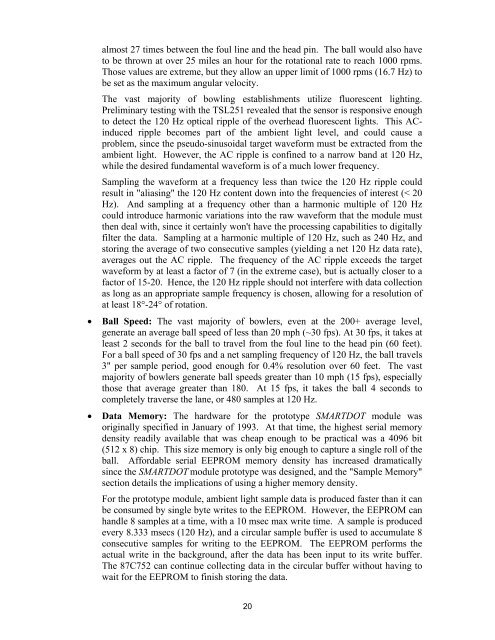A Performance Analysis System for the Sport of Bowling
A Performance Analysis System for the Sport of Bowling
A Performance Analysis System for the Sport of Bowling
Create successful ePaper yourself
Turn your PDF publications into a flip-book with our unique Google optimized e-Paper software.
almost 27 times between <strong>the</strong> foul line and <strong>the</strong> head pin. The ball would also have<br />
to be thrown at over 25 miles an hour <strong>for</strong> <strong>the</strong> rotational rate to reach 1000 rpms.<br />
Those values are extreme, but <strong>the</strong>y allow an upper limit <strong>of</strong> 1000 rpms (16.7 Hz) to<br />
be set as <strong>the</strong> maximum angular velocity.<br />
The vast majority <strong>of</strong> bowling establishments utilize fluorescent lighting.<br />
Preliminary testing with <strong>the</strong> TSL251 revealed that <strong>the</strong> sensor is responsive enough<br />
to detect <strong>the</strong> 120 Hz optical ripple <strong>of</strong> <strong>the</strong> overhead fluorescent lights. This ACinduced<br />
ripple becomes part <strong>of</strong> <strong>the</strong> ambient light level, and could cause a<br />
problem, since <strong>the</strong> pseudo-sinusoidal target wave<strong>for</strong>m must be extracted from <strong>the</strong><br />
ambient light. However, <strong>the</strong> AC ripple is confined to a narrow band at 120 Hz,<br />
while <strong>the</strong> desired fundamental wave<strong>for</strong>m is <strong>of</strong> a much lower frequency.<br />
Sampling <strong>the</strong> wave<strong>for</strong>m at a frequency less than twice <strong>the</strong> 120 Hz ripple could<br />
result in "aliasing" <strong>the</strong> 120 Hz content down into <strong>the</strong> frequencies <strong>of</strong> interest (< 20<br />
Hz). And sampling at a frequency o<strong>the</strong>r than a harmonic multiple <strong>of</strong> 120 Hz<br />
could introduce harmonic variations into <strong>the</strong> raw wave<strong>for</strong>m that <strong>the</strong> module must<br />
<strong>the</strong>n deal with, since it certainly won't have <strong>the</strong> processing capabilities to digitally<br />
filter <strong>the</strong> data. Sampling at a harmonic multiple <strong>of</strong> 120 Hz, such as 240 Hz, and<br />
storing <strong>the</strong> average <strong>of</strong> two consecutive samples (yielding a net 120 Hz data rate),<br />
averages out <strong>the</strong> AC ripple. The frequency <strong>of</strong> <strong>the</strong> AC ripple exceeds <strong>the</strong> target<br />
wave<strong>for</strong>m by at least a factor <strong>of</strong> 7 (in <strong>the</strong> extreme case), but is actually closer to a<br />
factor <strong>of</strong> 15-20. Hence, <strong>the</strong> 120 Hz ripple should not interfere with data collection<br />
as long as an appropriate sample frequency is chosen, allowing <strong>for</strong> a resolution <strong>of</strong><br />
at least 18°-24° <strong>of</strong> rotation.<br />
• Ball Speed: The vast majority <strong>of</strong> bowlers, even at <strong>the</strong> 200+ average level,<br />
generate an average ball speed <strong>of</strong> less than 20 mph (~30 fps). At 30 fps, it takes at<br />
least 2 seconds <strong>for</strong> <strong>the</strong> ball to travel from <strong>the</strong> foul line to <strong>the</strong> head pin (60 feet).<br />
For a ball speed <strong>of</strong> 30 fps and a net sampling frequency <strong>of</strong> 120 Hz, <strong>the</strong> ball travels<br />
3" per sample period, good enough <strong>for</strong> 0.4% resolution over 60 feet. The vast<br />
majority <strong>of</strong> bowlers generate ball speeds greater than 10 mph (15 fps), especially<br />
those that average greater than 180. At 15 fps, it takes <strong>the</strong> ball 4 seconds to<br />
completely traverse <strong>the</strong> lane, or 480 samples at 120 Hz.<br />
• Data Memory: The hardware <strong>for</strong> <strong>the</strong> prototype SMARTDOT module was<br />
originally specified in January <strong>of</strong> 1993. At that time, <strong>the</strong> highest serial memory<br />
density readily available that was cheap enough to be practical was a 4096 bit<br />
(512 x 8) chip. This size memory is only big enough to capture a single roll <strong>of</strong> <strong>the</strong><br />
ball. Af<strong>for</strong>dable serial EEPROM memory density has increased dramatically<br />
since <strong>the</strong> SMARTDOT module prototype was designed, and <strong>the</strong> "Sample Memory"<br />
section details <strong>the</strong> implications <strong>of</strong> using a higher memory density.<br />
For <strong>the</strong> prototype module, ambient light sample data is produced faster than it can<br />
be consumed by single byte writes to <strong>the</strong> EEPROM. However, <strong>the</strong> EEPROM can<br />
handle 8 samples at a time, with a 10 msec max write time. A sample is produced<br />
every 8.333 msecs (120 Hz), and a circular sample buffer is used to accumulate 8<br />
consecutive samples <strong>for</strong> writing to <strong>the</strong> EEPROM. The EEPROM per<strong>for</strong>ms <strong>the</strong><br />
actual write in <strong>the</strong> background, after <strong>the</strong> data has been input to its write buffer.<br />
The 87C752 can continue collecting data in <strong>the</strong> circular buffer without having to<br />
wait <strong>for</strong> <strong>the</strong> EEPROM to finish storing <strong>the</strong> data.<br />
20
















